Appendix a network system definition, A.1 communication protocol standard, A.3 fl-net physical layer – Yaskawa JAPMC-MC2303-E User Manual
Page 152

Appendix A Network System Definition
A.1 Communication Protocol Standard
A-2
Appendix A Network System Definition
A.1
Communication Protocol Standard
A communication protocol means a set of rules (communication rules) for information transfer from one system to
another via communication lines and vice-versa. The FL-net communication protocol complies with the following
standards.
A.2
Hierarchical Structure of Communication Protocol
The communication protocol has been modeled in a hierarchical structure and its communication processes are divided
into levels and arranged for representation and standardization. FL-net consists of six protocol layers as shown below.
A.3
FL-net Physical Layer
When the baud rate is 10 Mbps, the Ethernet physical layer supports five transmission systems: 10BASE5, 10BASE2,
10BASE-T, 10BASE-F, and 10BROAD36. In addition, when the baud rate is 100 Mbps, it supports four transmission
system: 100ASE-T2, 100BASE-T4, 100BASE-TX, and 100BASE-FX.
FL-net recommends 10BASE5, 10BASE2, 10BASE-T, 100BASE-TX, and 100BASE-FX among them.
FL-net Communication Protocol
Compliance Specifications
FL-net
FA Link Protocol Specifications
JIS B 3521, FA Control Network FL-net (OPCN2) – Protocol Specifications
UDP
RFC768
IP, IPMC, etc.
RFC791, 792, 919, 922, 950
ARP, etc.
RFC826, 894
Ethernet
IEEE802.3
FA link protocol layer
Application layer
Transport layer
Network layer
Data link layer
Physical layer
Controller or interface
UDP
Token function
Service function
Cyclic transmission
Message transmission
IP
Ethernet
(Based on IEEE802.3)
FL-net
protocol